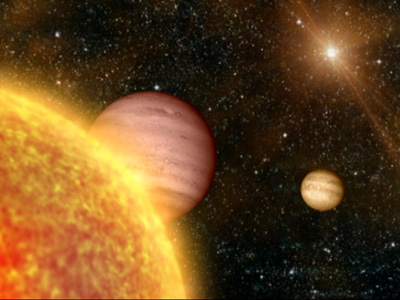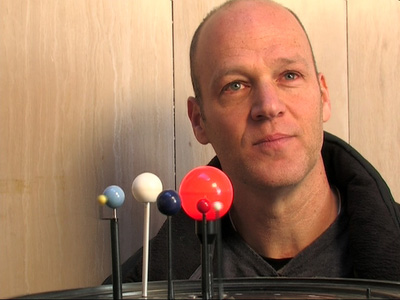In an article published today in Science, the researchers, who were also assisted by the Weiss Observatory in Mitzpe Ramon, write that the system contains a counterpart to Jupiter and Saturn that are about half the size of their counterparts and also relatively similar in distance

(Figure courtesy of Cheongho Han, Physics Department, Chungbuk National University, Korea)
By tracking the light from the system for two weeks around the clock using a network of telescopes around the world, the researchers were able to deduce the existence of a star surrounded by Jupiter and Saturn. Surprisingly, the system looks like a kind of "mini solar system": the mother planet has half the weight of the sun, "Jupiter" and "Saturn" about half the weight of these planets in our solar system, and their distances to the mother star are about half the distances of Jupiter and Saturn from the sun. This is the closest similarity achieved so far, in a universe where planets 10 times larger than Jupiter orbit at a distance similar to that of Mercury from the Sun, if we take an example of a typical solar system from those discovered so far.
"It can be said that this is a species of our solar system because all the proportions within it are half of ours, the star - the sun of the system is smaller than the sun, about half the mass of the sun and also the masses of the planets are about half of those of Jupiter and Saturn respectively. Prof. Dan Maoz from Tel Aviv University said in a phone call from Florence, where he is a researcher at the National Institute of Astrophysics as part of the sabbatical year. "However, if you compare this system to the other known systems - they are all completely different from the solar system, and this is the first one that bears at least a general resemblance to our solar system."

"The idea is that you follow the light of several million stars and look for a brightening of a certain star that indicates that some other star or a star with a planetary system passes exactly in the line of sight to the star in the background and the star in between is used as a lens that focuses the light of the star in the background. The reason we need to track millions of stars is because the alignment of three bodies in this way is rare, but when it happens we can analyze the properties of the system that is in the middle and serves as a lens." says Maoz and adds that because of the complexity of the method, few planets were discovered through it.
"The systems discovered by this method are necessarily distant. However, it has the potential to find systems not only with Jupiter and Saturn but also with Earth, if they exist."
What is the distance from us to the system, and will it be possible to see it even after the star in the background recedes and weakens again?
Prof. Maoz: "The system is 5,000 light years away. After time passes the system continues to move and moves away from our line of sight and then you can try to see it separately. Although the light will be very weak, it will be possible to do this with the help of space telescopes."
As you know, the study of planets outside the solar system is a relatively new scientific field, only in the mid-nineties did scientists begin to discover such planets. And Maoz explains: "15 years ago we didn't even know if we (in the solar system) were the only case, in the last 15 years we understand that planets are a common phenomenon around other stars, but the visible method that was used until now was sensitive to systems very different from the solar system, in the sense of very large planets that are very close to their parent star these are the systems that have been discovered. We knew there were quite a few solar systems but we didn't discover anything close to the solar system. With this discovery, of course, it is too early to say that a few more examples are needed, but it seems that systems like the solar system are also common."
"So far, only five planets have been discovered using the gravitational lensing method. The fact that we have already found a system so similar to the solar system suggests that such systems are common around many stars, and may also include Earth-like planets. Although, if there are other "Earths", observations such as these will soon discover them."
The Israeli data collected at the Mitzpe Wiz in Mitzpe Ramon was essential to the discovery, explains Dr. Shai Caspi, another partner in the project: "Without our observations, which were made when it was daylight for the other telescopes in the network, it would not have been possible to conclude on the existence of the Justice" in the system." Prof. Dan Ma'oz adds: "Our contribution was critical because the changes in the star's brightness that are rising and falling can be inferred from the system, and the discovery of the light signature of the system's 'justice' was only seen by observers at the Mitzpe Ramon Observatory. Only we were in a position that could be observed when it happened. Without our data it would have been very difficult to say that this is a system of more than one planet and it is no longer such a new thing."
When were these observations made?
Prof. Maoz: "The observations were made in the months of March-April 2006, a year and a half ago, the long time that has passed is because of the difficulty in analyzing the data. A general picture of what we see, we understood straight away, but to be sure of the data of the system and that it is impossible to explain what we saw in any other way, it required many computer hours to check all the possibilities, all the combinations of stars, planets, at all distances and masses in order to come to the conclusion that this is the only solution . This process took about a year and a half."
On the same topic on the science site
How do you discover a planet similar to Earth?
A moon like ours is not common in the universe
A system with five planets was discovered

5 תגובות
thanks Michael…
Hanan:
http://www.astro.ucla.edu/~wright/distance.htm
I have a question that maybe someone here can answer.
How do you know how far a star is from the Earth?
After all, in order to know the size of a star, you need to know how far it is from the Earth in order to understand by the intensity of the light how much it weakened until it reached us.
But how can we know how far he is from us?
Likewise, I also know that the universe is in motion, both expanding and moving in circles in solar systems, galaxies and clusters. Therefore the distance is not constant. So if there is already a way to calculate a distance, what distance is considered the official distance?
I would appreciate it if someone knows the answer to my question or can direct me to an article on the subject.
Thanks,
Hanan
It's off topic well maybe a little
I recently found something interesting on the Internet
Search on Google for lifter. It is supposed to be a hovering device powered by electricity that creates power (?) which is not understood yet and it is not clear what it is. I tried to build it at home and failed. If anyone knows the subject, maybe they also tried to build the device.
is the site from which I tried to build the facility
http://jnaudin.free.fr/lifters/main.htm
Is there any research on this in Israel???.?